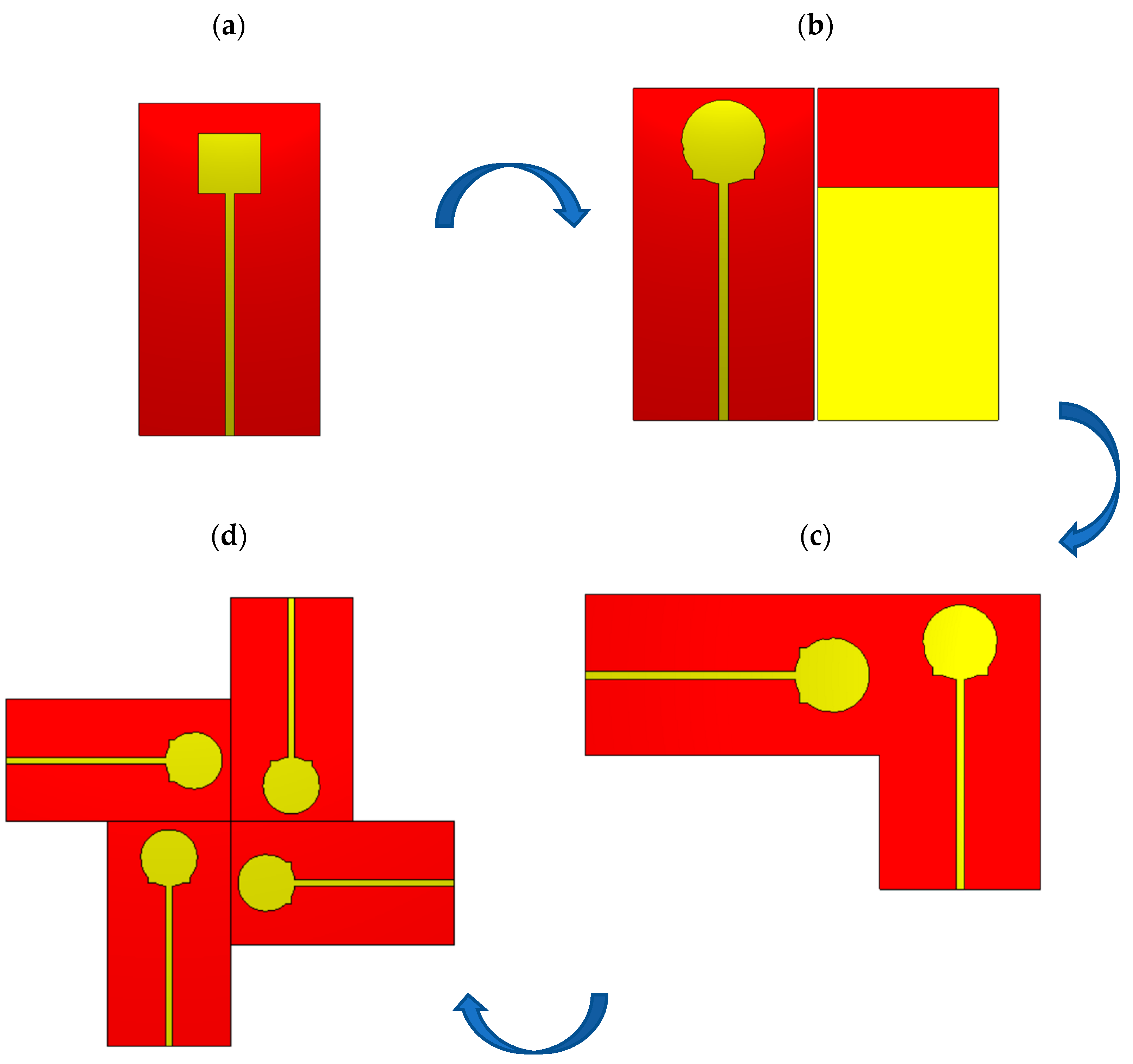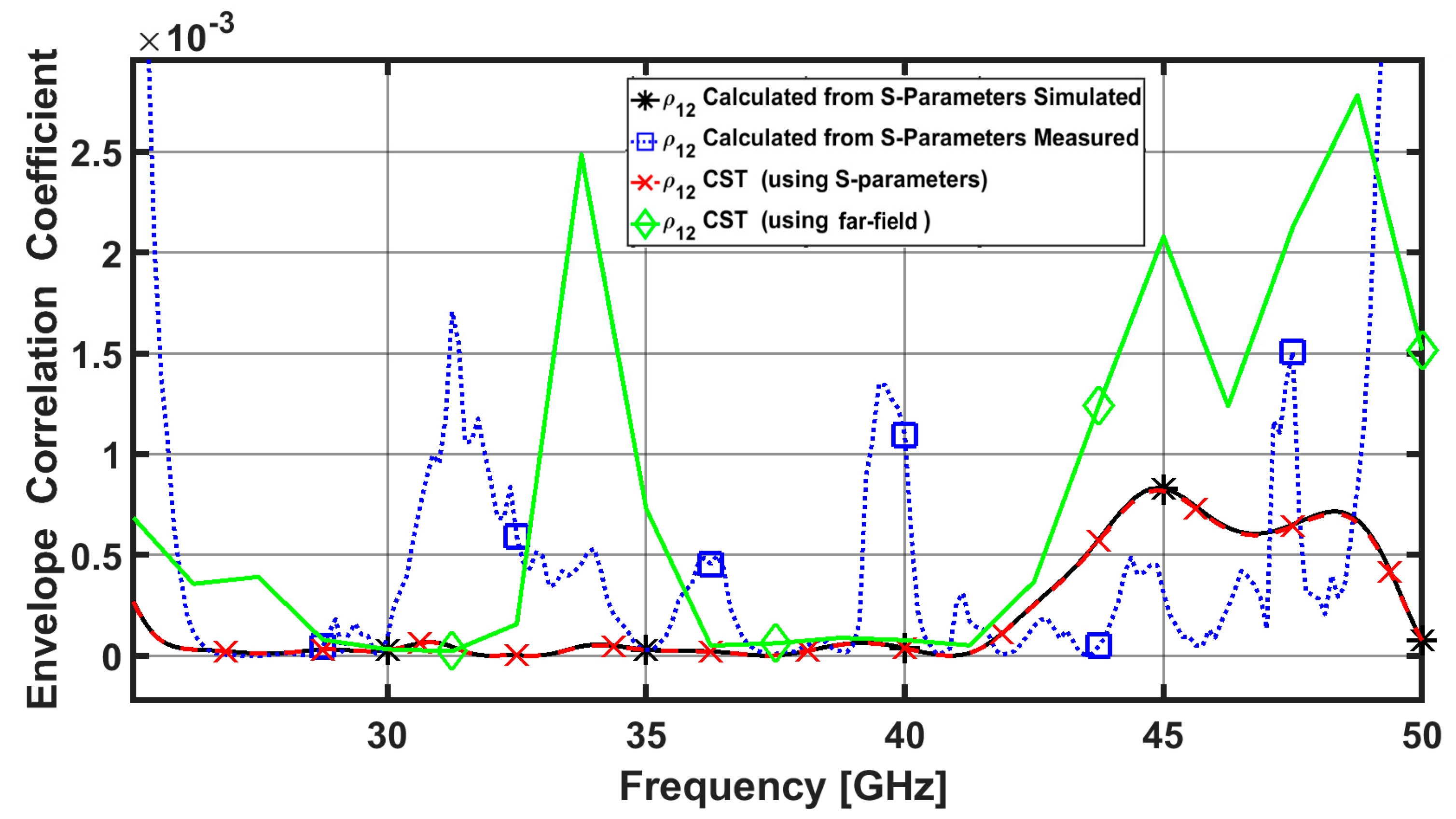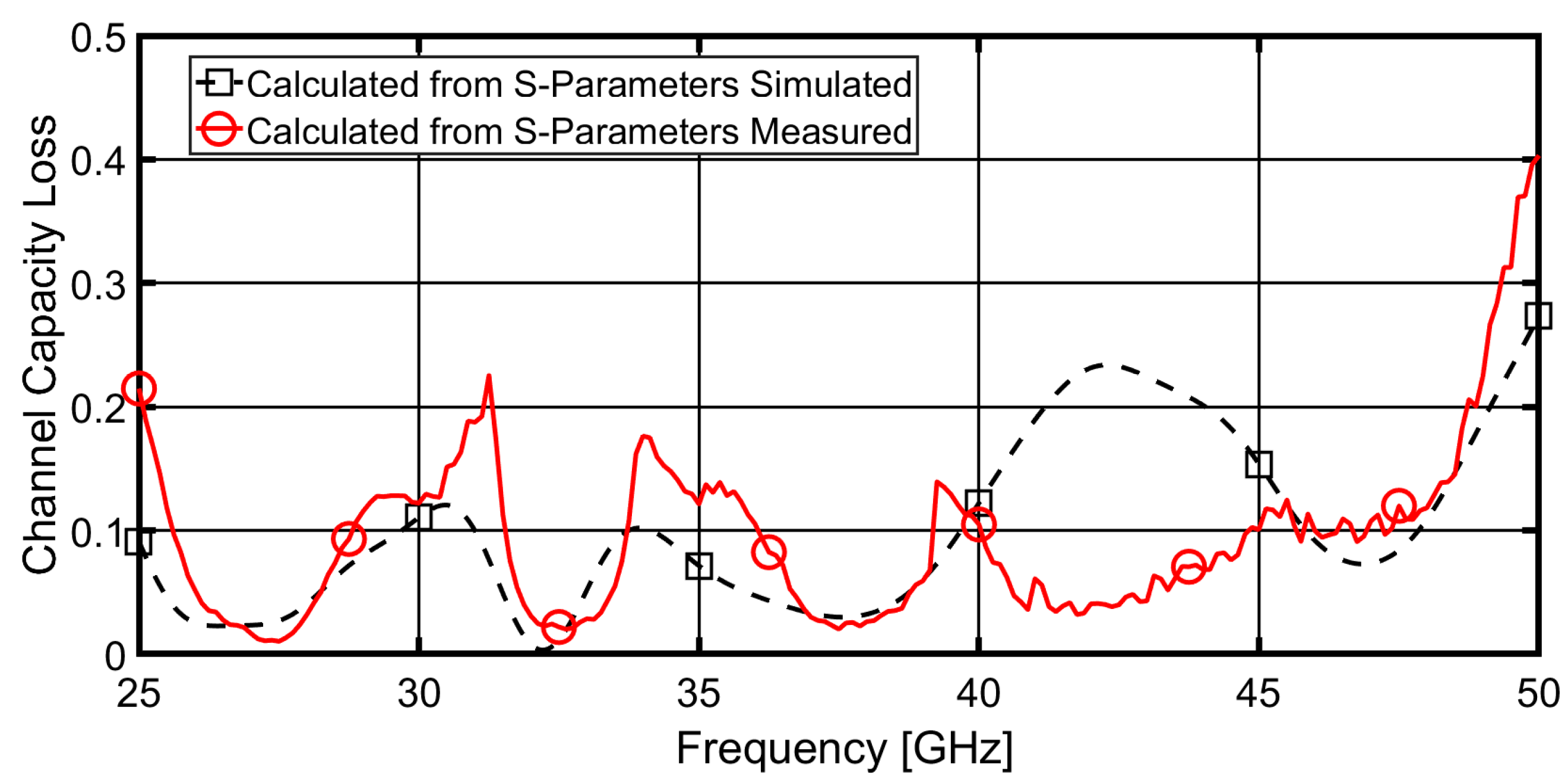Compact UWB MIMO Antenna for 5G Millimeter-Wave Applications
Abstract
:1. Introduction
2. Antenna Design
3. MIMO Antenna Parameters for Performance Evaluations
3.1. Envelope Correlation Coefficient (ECC)
3.2. Diversity Gain (DG)
3.3. Channel Capacity Loss (CCL)
3.4. Multiplexing Efficiency (ME)
3.5. Total Active Reflection Coefficient (TARC)
4. Performance Comparison
5. Conclusions
Author Contributions
Funding
Institutional Review Board Statement
Informed Consent Statement
Data Availability Statement
Conflicts of Interest
References
- Rappaport, T.S.; Sun, S.; Mayzus, R.; Zhao, H.; Azar, Y.; Wang, K.; Wong, G.N.; Schulz, J.K.; Samimi, M.; Gutierrez, F. Millimeter Wave Mobile Communications for 5G Cellular: It Will Work! IEEE Access 2013, 1, 335–349. [Google Scholar] [CrossRef]
- Hasan, M.; Faruque, M.R.I.; Islam, M.T. Dual Band Metamaterial Antenna For LTE/Bluetooth/WiMAX System. Sci. Rep. 2018, 8, 1240. [Google Scholar] [CrossRef] [Green Version]
- Katalinic, A.; Nagy, R.; Zentner, R. Benefits of MIMO Systems in Practice: Increased Capacity, Reliability and Spectrum Efficiency. In Proceedings of the Proceedings ELMAR 2006, Zadar, Croatia, 7–10 June 2006; pp. 263–266. [Google Scholar] [CrossRef]
- Molisch, A.; Win, M. MIMO systems with antenna selection. IEEE Microw. Mag. 2004, 5, 46–56. [Google Scholar] [CrossRef]
- Paulraj, A.; Gore, D.; Nabar, R.; Bolcskei, H. An Overview of MIMO Communications—A Key to Gigabit Wireless. Proc. IEEE 2004, 92, 198–218. [Google Scholar] [CrossRef] [Green Version]
- Pi, Z.; Khan, F. An introduction to millimeter-wave mobile broadband systems. IEEE Commun. Mag. 2011, 49, 101–107. [Google Scholar] [CrossRef]
- Nadeem, I.; Choi, D.-Y. Study on Mutual Coupling Reduction Technique for MIMO Antennas. IEEE Access 2018, 7, 563–586. [Google Scholar] [CrossRef]
- Kumar, S.; Dixit, A.S.; Malekar, R.R.; Raut, H.D.; Shevada, L.K. Fifth Generation Antennas: A Comprehensive Review of Design and Performance Enhancement Techniques. IEEE Access 2020, 8, 163568–163593. [Google Scholar] [CrossRef]
- Dixit, A.S.; Kumar, S. A Survey of Performance Enhancement Techniques of Antipodal Vivaldi Antenna. IEEE Access 2020, 8, 45774–45796. [Google Scholar] [CrossRef]
- Farida, S.F.; Hadalgi, P.; Hunagund, P.; Ara, S.R. Effect of substrate thickness and permittivity on the characteristics of rectangular microstrip antenna. In Proceedings of the 1998 Conference on Precision Electromagnetic Measurements Digest (Cat. No. 98CH36254), Washington, DC, USA, 6–10 July 1998. [Google Scholar] [CrossRef]
- Honari, M.M.; Ghaffarian, M.S.; Mousavi, P.; Sarabandi, K. A Wideband High-Gain Planar Corrugated Antenna. In Proceedings of the 2020 IEEE International Symposium on Antennas and Propagation and North American Radio Science Meeting, Montreal, QC, Canada, 5–10 July 2020; pp. 7–8. [Google Scholar] [CrossRef]
- Wang, Z.; Dou, W. Dielectric lens antennas designed for millimeter wave application. In Proceedings of the 2006 Joint 31st International Conference on Infrared Millimeter Waves and 14th International Conference on Teraherz Electronics, Shanghai, China, 18–22 September 2006; p. 376. [Google Scholar] [CrossRef]
- Zhang, Z.; Li, X.; Sun, C.; Liu, Y.; Han, G. Dual-Band Focused Transmitarray Antenna for Microwave Measurements. IEEE Access 2020, 8, 100337–100345. [Google Scholar] [CrossRef]
- Dey, S.; Dey, S.; Koul, S.K. Isolation Improvement of MIMO Antenna Using Novel EBG and Hair-Pin Shaped DGS at 5G Millimeter Wave Band. IEEE Access 2021, 9, 162820–162834. [Google Scholar] [CrossRef]
- Goswami, C.; Roy, B.; Bhattacharya, P.; Ray, S.; Ghosh, S.; Ghosh, D.; Saha, D.; Jana, T.; Chatterjee, S. Complementary Split Rings Resonator Based Circular Microstrip Antenna for Wireless Applications. In Proceedings of the 2019 IEEE International Electromagnetics and Antenna Conference (IEMANTENNA), Vancouver, BC, Canada, 17–19 October 2019; pp. 065–067. [Google Scholar] [CrossRef]
- Ziolkowski, R.W. Metamaterials and Antennas. In Handbook of Antenna Technologies; Chen, Z., Liu, D., Nakano, H., Qing, X., Zwick, T., Eds.; Springer: Singapore. [CrossRef]
- Chen, Z.; Tang, M.-C.; Wang, Y.; Li, M.; Li, D. Mutual Coupling Reduction Using Planar Parasitic Resonators for Wideband, Dual-Polarized, High-Density Patch Arrays. In Proceedings of the 2019 IEEE MTT-S International Wireless Symposium (IWS), Guangzhou, China, 19–22 May 2019; pp. 1–3. [Google Scholar] [CrossRef]
- Iqbal, A.; Saraereh, O.A.; Ahmad, A.W.; Bashir, S. Mutual Coupling Reduction Using F-Shaped Stubs in UWB-MIMO Antenna. IEEE Access 2017, 6, 2755–2759. [Google Scholar] [CrossRef]
- Chandel, R.; Gautam, A.K.; Rambabu, K. Tapered Fed Compact UWB MIMO-Diversity Antenna with Dual Band-Notched Characteristics. IEEE Trans. Antennas Propag. 2018, 66, 1677–1684. [Google Scholar] [CrossRef]
- Karaboikis; Soras; Tsachtsiris; Makios Compact dual-printed inverted-F antenna diversity systems for portable wireless devices. IEEE Antennas Wirel. Propag. Lett. 2004, 3, 9–14. [CrossRef]
- Li, Z.; Yin, C.; Zhu, X. Compact UWB MIMO Vivaldi Antenna With Dual Band-Notched Characteristics. IEEE Access 2019, 7, 38696–38701. [Google Scholar] [CrossRef]
- El-Din, M.S.H.S.; Shams, S.I.; Allam, A.M.M.A.; Gaafar, A.; Elhennawy, H.M.; Sree, M.F.A. SIGW Based MIMO Antenna for Satellite Down-Link Applications. IEEE Access 2022, 10, 35965–35976. [Google Scholar] [CrossRef]
- Alibakhshikenari, M.; Virdee, B.S.; See, C.H.; Abd-Alhameed, R.; Falcone, F.; Limiti, E. A new waveguide slot array antenna with high isolation and high antenna bandwidth operation on Ku- and K-bands for radar and MIMO systems. In Proceedings of the 2018 15th European Radar Conference (EuRAD), Madrid, Spain, 26–28 September 2018; pp. 401–404. [Google Scholar]
- Alibakhshikenari, M.; Virdee, B.S.; See, I.C.H.; Abd-Alhameed, R.; Falcone, F.; Andújar, A.; Anguera, J.; Limiti, E. Study on antenna mutual coupling suppression using integrated metasurface isolator for SAR and MIMO applications. In Proceedings of the 2018 48th European Microwave Conference (EuMC), Madrid, Spain, 23–27 September 2018; pp. 1425–1428. [Google Scholar]
- Biswas, A.K.; Chakraborty, U. Textile Multiple Input Multiple Output Antenna for X-Band and Ku-Band Uplink-downlink Applications. In Proceedings of the 2020 National Conference on Emerging Trends on Sustainable Technology and Engineering Applications (NCETSTEA), Durgapur, India, 7–8 February 2020; pp. 1–4. [Google Scholar] [CrossRef]
- Kumar, N.; Kumar, P.; Sharma, M. Superwideband Dual Notched Band Square Monopole MIMO Antenna for UWB/X/Ku Band Wireless Applications. In Proceedings of the 2019 IEEE Indian Conference on Antennas and Propogation (InCAP), Ahmedabad, India, 19–22 December 2019; pp. 1–5. [Google Scholar] [CrossRef]
- Sharawi, M.S. Printed Multi-Band MIMO Antenna Systems and Their Performance Metrics [Wireless Corner]. IEEE Antennas Propag. Mag. 2013, 55, 218–232. [Google Scholar] [CrossRef]
- Sharawi, M.S. Printed MIMO Antenna Engineering; Artech House: Norwood, MA, USA, 2014. [Google Scholar]
- Manteghi, M.; Sami, Y.R. Broadband Characterization of the Total Active Reflection Coefficient of Multiport Antennas. In Proceedings of the IEEE Antennas and Propagation Society International Symposium (APS2003), Columbus, OH, USA, 22–27 June 2003; Volume 3, pp. 20–23. [Google Scholar]
- Abdelraheem, A.; Elregaily, H.; Mitkees, A.A.; Abdalla, M. A Hybrid Isolation in Two-Element Directive UWB MIMO Antenna. IETE J. Res. 2020, 69, 499–508. [Google Scholar] [CrossRef]
- Available online: https://rogerscorp.com/advanced-electronics-solutions/ro4000-series-laminates/ro4003c-laminates. (accessed on 20 December 2021).
- Available online: https://rogerscorp.com/-/media/project/rogerscorp/documents/advanced-electronics-solutions/english/data-sheets/ro4000-laminates-ro4003c-and-ro4350b---data-sheet.pdf. (accessed on 20 December 2021).
- Available online: https://scdn.rohde-schwarz.com/ur/pws/dl_downloads/dl_common_library/dl_brochures_and_datasheets/pdf_1/ZVA_dat-sw_en_5213-5680-22_v1400.pdf. (accessed on 20 December 2021).
- Balanis, C. Antenna Theory: Analysis and Design; Wiley: New York, NY, USA, 1997. [Google Scholar]
- Sarkar, D.; Mikki, S.; Srivastava, K.V.; Antar, Y. Far-field Envelope Correlation Coefficient and Near-field Reactive Energy of MIMO Antennas: An FDTD-IDM-CGF Approach. In Proceedings of the 2019 URSI Asia-Pacific Radio Science Conference (AP-RASC), New Delhi, India, 9–15 March 2019. [Google Scholar] [CrossRef]
- Mei, X.; Wu, K.-L. Envelope Correlation Coefficient for Multiple MIMO Antennas of Mobile Terminals. In Proceedings of the 2020 IEEE International Symposium on Antennas and Propagation and North American Radio Science Meeting, Montreal, QC, Canada, 5–10 July 2020; pp. 1597–1598. [Google Scholar] [CrossRef]
- Tariq, S.; Naqvi, S.I.; Hussain, N.; Amin, Y. A Metasurface-Based MIMO Antenna for 5G Millimeter-Wave Applications. IEEE Access 2021, 9, 51805–51817. [Google Scholar] [CrossRef]
- Tian, R.; Lau, B.K.; Ying, Z. Multiplexing Efficiency of MIMO Antennas. IEEE Antennas Wirel. Propag. Lett. 2011, 10, 183–186. [Google Scholar] [CrossRef] [Green Version]
- Chae, S.H.; Kawk, W.I.; Park, S.-O.; Lee, K. Analysis of mutual coupling in MIMO antenna array by TARC calculation. In Proceedings of the 2006 Asia-Pacific Microwave Conference, Yokohama, Japan, 12–15 December 2006; pp. 2090–2093. [Google Scholar] [CrossRef]
- Wu, A.; Zhao, M.; Zhang, P.; Zhang, Z. A Compact Four-Port MIMO Antenna for UWB Applications. Sensors 2022, 22, 5788. [Google Scholar] [CrossRef]
- Bilal, M.; Naqvi, S.I.; Hussain, N.; Amin, Y.; Kim, N. High-Isolation MIMO Antenna for 5G Millimeter-Wave Communication Systems. Electronics 2022, 11, 962. [Google Scholar] [CrossRef]
- Fat, S.Y.A.; Hamad, E.K.I.; Swelam, W.; Allam, A.M.; Mohamed, H.A.E. Design of compact 4-port MIMO antenna based on Minkowski fractal shape DGS for 5G applications. Prog. Electromagn. Res. C 2021, 113, 123–136. [Google Scholar] [CrossRef]
- Kumar, A. Compact 4 × 4 CPW-Fed MIMO Antenna with Wi-Fi and WLAN Notch for UWB Applications. Radioelectron. Commun. Syst. 2021, 64, 92–98. [Google Scholar] [CrossRef]
- Hussain, M.; Ali, E.M.; Jarchavi, S.M.R.; Zaidi, A.; Najam, A.I.; Alotaibi, A.A.; Althobaiti, A.; Ghoneim, S.S.M. Design and Characterization of Compact Broadband Antenna and Its MIMO Configuration for 28 GHz 5G Applications. Electronics 2022, 11, 523. [Google Scholar] [CrossRef]
- Li, M.-Y.; Ban, Y.-L.; Xu, Z.-Q.; Guo, J.; Yu, Z.-F. Tri-Polarized 12-Antenna MIMO Array for Future 5G Smartphone Applications. IEEE Access 2017, 6, 6160–6170. [Google Scholar] [CrossRef]
- Fatah, S.Y.A.; Hamad, E.K.I.K.I.; Swelam, W.; Allam, A.M.M.A.; Sree, M.F.A.; Mohamed, H.A. Design and Implementation of UWB Slot-Loaded Printed Antenna for Microwave and Millimeter Wave Applications. IEEE Access 2021, 9, 29555–29564. [Google Scholar] [CrossRef]











| Reference | Physical Dimension (mm2), Number of Ports | Substrate Thickness | Frequency, Band (B.W), Fractional B.W (GHz%) | MIMO Parameters | Mutual Coupling Reduction Technique | ||||
|---|---|---|---|---|---|---|---|---|---|
| ECC | DG | CCL | ME | TARC | |||||
| [41] | 80 × 80 4 ports | Roger 5880, 0.508 | 23–40, 17, 53% | <0.0014 | NA | NA | NA | NA | DGS |
| [42] | 23.75 × 42.5 4 Ports | Roger 5880, 0.508 | 24–28, 4, 14.2% | <0.002 | 9.9 | <0.001 | N/A | N/A | DGS |
| [43] | 45 × 45 4 Ports | FR-4 , 1.6 | 4.98–5.98, 1, 16.7% | <0.0022 | 9.95 | <0.4 | N/A | CALC. | Floating Parasitic Element |
| [44] | 30 × 30 4 ports | Roger 5880, 1.575 | 25–31, 6, 21.1% | <0.0005 | NA | 0.15 | NA | NA | DGS |
| [45] | 17 × 17 4 Ports | FR-4 , 0.8 | 3.4–3.6, 0.2, 5.5% | 0.2 | NA | 57 | CALC. | NA | Orthogonal Polarization |
| [46] | 5 × 4 Single | Roger 5880, 1.575 | 5.5–9.5, 4, 40% | N/A | N/A | N/A | N/A | N/A | N/A |
| Proposed Antenna | 33 × 33 4 Ports | RO4003C, 0.203 | 25–50, 25, 66% | <0.005 | ≈10 | <0.25 | >0.85 | <−10 | Orientation and DGS |
Disclaimer/Publisher’s Note: The statements, opinions and data contained in all publications are solely those of the individual author(s) and contributor(s) and not of MDPI and/or the editor(s). MDPI and/or the editor(s) disclaim responsibility for any injury to people or property resulting from any ideas, methods, instructions or products referred to in the content. |
© 2023 by the authors. Licensee MDPI, Basel, Switzerland. This article is an open access article distributed under the terms and conditions of the Creative Commons Attribution (CC BY) license (https://creativecommons.org/licenses/by/4.0/).
Share and Cite
Abbas, M.A.; Allam, A.; Gaafar, A.; Elhennawy, H.M.; Sree, M.F.A. Compact UWB MIMO Antenna for 5G Millimeter-Wave Applications. Sensors 2023, 23, 2702. https://doi.org/10.3390/s23052702
Abbas MA, Allam A, Gaafar A, Elhennawy HM, Sree MFA. Compact UWB MIMO Antenna for 5G Millimeter-Wave Applications. Sensors. 2023; 23(5):2702. https://doi.org/10.3390/s23052702
Chicago/Turabian StyleAbbas, Mohamed Atef, Abdelmegid Allam, Abdelhamid Gaafar, Hadia M. Elhennawy, and Mohamed Fathy Abo Sree. 2023. "Compact UWB MIMO Antenna for 5G Millimeter-Wave Applications" Sensors 23, no. 5: 2702. https://doi.org/10.3390/s23052702







